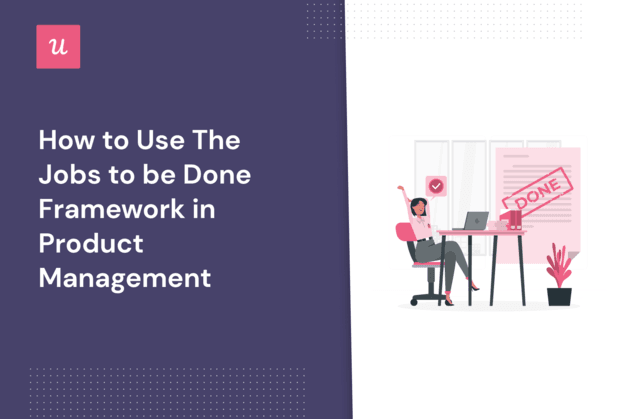
Try Userpilot Now
See Why 1,000+ Teams Choose Userpilot

What is the jobs-to-be-done model in product management?
Jobs-to-be-done is a framework based on the idea that customers ‘hire’ services or products to get their ‘jobs’ done.
What do we mean by ‘jobs’? These could be various tasks, goals, or objectives. It could also mean problems and challenges that need solving – and whatever else your private or professional life throws at you.
To build an attractive product, your product team needs to understand what their users want to achieve. They also need to figure out what could lead a potential customer to start seeing your product as a solution.
What’s your main goal for using the jobs-to-be-done model in product management?
How do you currently gather insights about your users’ ‘jobs’?
Once you’ve identified a key ‘job’, what’s the biggest challenge in addressing it?
Unlock the Full Potential of the Jobs-to-be-Done Model
You’re asking the right questions. The key to the jobs-to-be-done model in product management isn’t just understanding the ‘job’—it’s guiding users to your solution in-app. Userpilot helps you build targeted onboarding and collect contextual feedback to ensure your product gets ‘hired’ every time.
What is the origin of the jobs-to-be-done framework?
The jobs-to-be-done model is the brainchild of Tony Ulwick, the founder of Strategyn.
It all started with Ulwick patenting Outcome-Driven Innovation (ODI). It was a process that aimed to identify the outcomes that their clients wanted to achieve, and only then focus on the solutions.
The framework turned out to be very effective. Their clients have successfully used it to develop and innovate their products to better meet the needs of their customers.
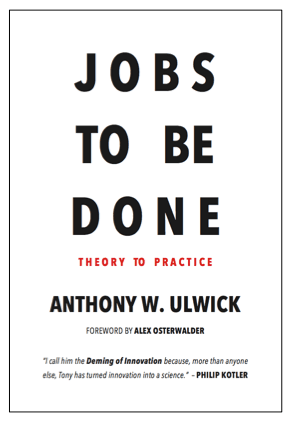
Different interpretations of the jobs-to-be-done framework
There are a couple of interpretations of the term ‘jobs’ which affect how the framework is applied in practice.
Jobs-As-Activities
The Jobs-As-Activities interpretation states that customers hire products to use for work. They see them as tools that help them complete the tasks which they have on their lists.
An example of jobs-as-activities could be listening to music (for a music player) or finding a partner (for a dating service).
If they go with this interpretation, the JTBD model will help product managers identify and organize their customer’s needs.
Your goal when using this interpretation is to enhance product effectiveness.
Jobs-As-Progress
The Jobs-As-Progress interpretation presents products as means of improving customers’ lives.
According to this interpretation, customers buy products to make their lives better. The product helps them make the job easier to complete or allows them to avoid it completely.
When you use it in this way, the JTBD model helps you understand customers’ motivation when they reach for your product. Understanding customer pain points allows you to innovate your product to solve them more effectively.
If you wanted to use the example above, listening to music wouldn’t be the ultimate goal but rather a means of achieving something else. This could be making their gym workouts easier. Our portable music player could help them achieve that.
Similarly, the dating app could be a means of improving life too. For example, it could solve the problem of loneliness. It is also much easier and safer to use a dating app than to chat people up in bars.
What are the core principles of the jobs-to-be-done framework in product management?
Let’s have a look at the main ideas the jobs-to-be-done model is based on.
People don’t buy your product, they hire it
The customer is interested in your product only as long as it is useful. However, as soon as they don’t need it or a new product that meets their needs better appears, they will lay your product off.
This may sound harsh but this realization can keep you on your toes and help you stay competitive. Companies that start taking their customers for granted and stop innovating, quickly lose their competitive edge, and they get ‘fired’.
Jobs are functional – with emotional and social components
While developing your product you can’t focus on its functionality and effectiveness. The emotional and social aspects of interacting with a product are equally important.
From a purely functional point of view, your product may need to tick all the boxes but still not sell because of the way it looks or the associations it brings.
Thats’ why when designing your product you must look at these factors as well. By offering your users a choice of different levels of experience, you increase your chances of satisfying their needs.
Jobs to be done vs user stories
The main difference between jobs-to-be-done and user stories is that the first focus on the desired outcome while the latter on the solution.
As we said before, a job-to-be-done is what a user wants to achieve. It tells you what tasks they want to complete or what problem they face. However, it doesn’t say anything about how to do it.
User stories follow this template:
As [a user], I want to [action] so that I can [outcome].
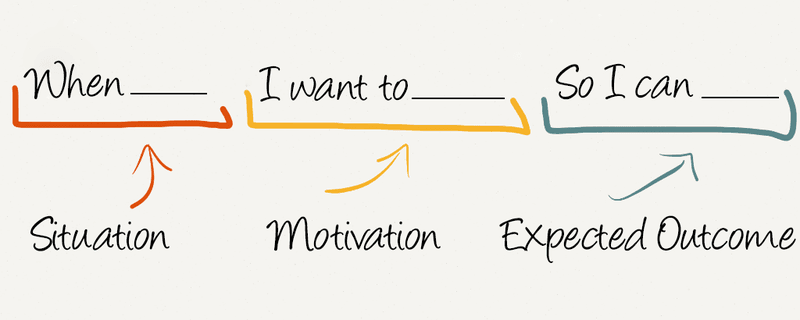
In other words, they describe specific features of a product from the point of view of a specific user persona and explain why this user persona needs it. The focus is on the output.
They both serve a purpose at different stages of the product management process. Jobs-to-be-done are important at the product discovery stage, while user stories give focus to the development teams working on specific features.
Why your product team should use the jobs-to-be-done model?
This framework is a great tool that helps you structure your customer research.
Thanks to it, your focus is on identifying the needs of your users and what they are trying to accomplish to improve their lives. By knowing these, you can develop your product to satisfy their needs.
By approaching product development from the perspective of outcomes, your teams can evaluate multiple solutions and pick those that will bring the most value to the customers.
At the same time, the framework helps you avoid falling into the build trap. It makes it easier to keep the solutions aligned with the problems that your customers are trying to solve. As a result, you commit your resources to develop only the features that directly help users achieve their goals.
The JTDB framework also helps your team prioritize the problems to solve. Your users may face lots of problems but only a few of them are significant enough to make a real difference in their lives. These are the ones you need to target.
What are some of the drawbacks of this approach?
One of the challenges that product teams face is that some of the jobs to be done can be very abstract. This may make it really difficult to identify specific features needed to realize the goals. Team members can also have competing views as to how to solve the user problems.
More thorough user research should help you describe the needs of the customers in more detail and consequently prioritize the features in the roadmap.
While focusing on the ultimate goal that the product must achieve and its functionality, teams may also forget about other aspects of user experience. These days it isn’t enough for a product to simply do the job. It also needs to be esthetically pleasing and otherwise delight users.
Steps to apply the JTBD framework to your SaaS product
Now that we understand the main principles behind the JTBD model, it’s time to see how you can apply it to your SaaS product development.
Identify the customers’ jobs-to-be-done
The first step is working out the jobs-to-be-done for your customers.
Your goal at this stage is to understand what your customers are trying to accomplish, the problems they’re trying to solve, and the pain points that are giving them grief.
If you’re working on a new product, you need to focus on areas where there is a void in the market. Look for problems that don’t have enough solutions and think about how you could help your customers solve them. Robust market research can help you identify them.
If you’re working on innovations to your existing products, use the user behavior data and their feedback to find the areas where your product may not be fulfilling their needs.
Onboarding microsurveys
Onboarding microsurveys can give you lots of insights into who your customers are and what jobs they’re trying to get done.
By collecting the data at the beginning of the user journey, you can guide them to the features that will solve the problems best. You can also use the input to inform future product development.
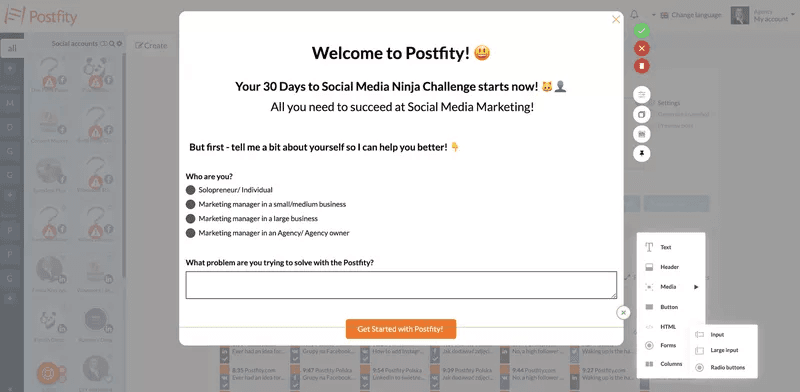
Customer interviews
Customer interviews are another way of identifying the outcomes that your users are after.
Your sales and customer success teams have access to your customers before they even start using your product. This gives you a chance to identify their needs and tailor their product experience so that they are satisfied in the best possible way.
Categorize the jobs-to-be-done
Once you have the jobs-to-be-done listed, it’s time to classify them.
We start by dividing them into 2 main categories: main and related jobs-to-be-done.
Main jobs-to-be-done are the ultimate outcomes that the users want to achieve. For an instant messaging app, this would be synchronous and asynchronous communication with their connections.
Related jobs-to-be-done are those that users want to complete along with the main ones. For the messaging system, that could be storing contact details or creating connection groups.
You can further divide them into functional and emotional jobs-to-be-done.
The first of them is quite self-explanatory. Communicating with friends and family is an example of a functional job-to-be-done.
The emotional aspects are linked to feelings and perception of reality. In our example, it could be the need to maintain relationships with people that are important to us.
The emotional aspects can have either a personal or social dimension. The first of them is to do with our own feelings and needs while the latter is to do with how we want to be perceived in our relations with other people.
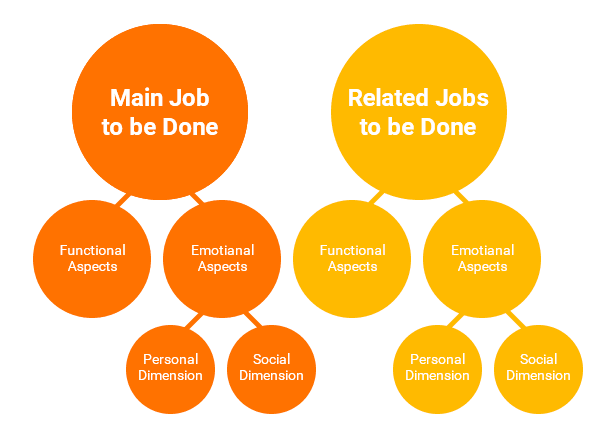
Create the job map
Job maps outline the process that the customer goes through when they want to accomplish a specific task.
The process is not necessarily sequential, the activities could be happening in a different order or in unison, hence the term ‘map’. Its job is to identify all the possible ways in which users are currently trying to accomplish their jobs.
The steps could include:
- Definition and planning – development of a rough initial idea on how to solve the problem.
- Research – a collection of the information necessary to get the job done.
- Preparation – analysis of the information available and filling in the gaps with more data.
- Confirmation and validation – the decision to act in a particular way.
- Execution – implementation of the plan.
- Monitoring – assessment of the effectiveness of their actions.
- Modification – adjustments to the way they try to complete the task based on the data from the monitoring stage.
- Conclusion – The end of the journey, is dependent on whether they are satisfied with the outcomes or not.
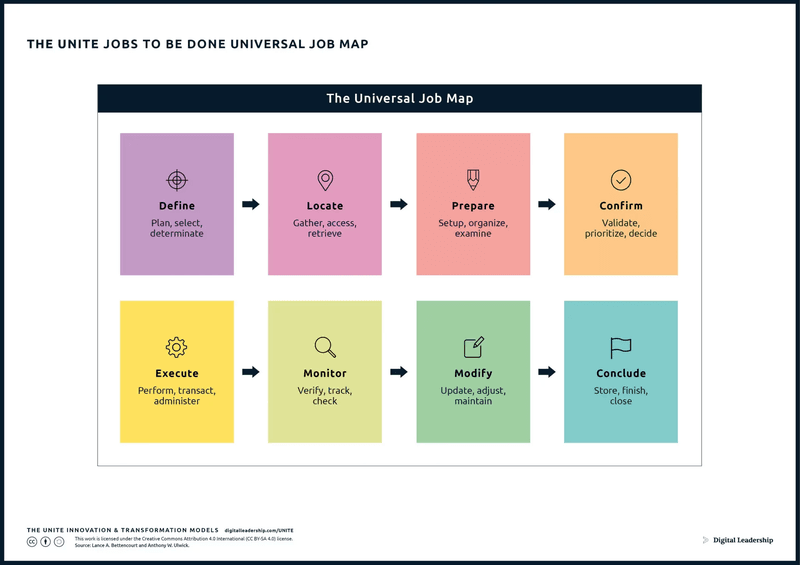
Determine which jobs you want to address with your product
You can’t solve everyone’s every problem. When you try to do that, there is a big chance your product will not solve any of them well enough to be competitive.
Instead, you should focus on helping your customers accomplish the key jobs that will improve their lives the most, and continue doing so over longer periods of time.
The latter point is critical to make sure that your product stays relevant. If you choose the wrong jobs to focus on, your product can cause a bit of initial excitement, but will soon be forgotten.
Look at the jobs to be done you’ve listed during your market and user research and use the insights to select the most valuable items from the list.
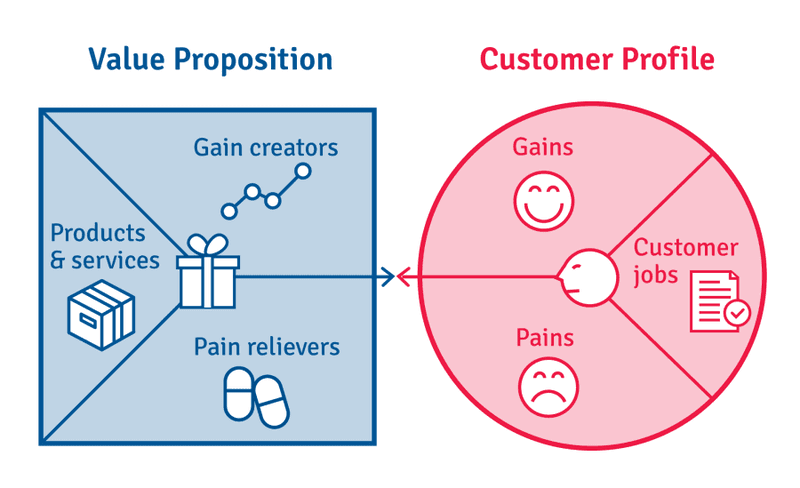
Some create JTBD backlog. They use the same techniques to manage and prioritize their items as they do with user stories.
You may also leverage other tools such as Opportunity Solution Trees to make sure alignment between your North Star, your user needs, and the solutions that you offer.
How to use JTBD to increase product adoption
The JTBD framework can be used not only to develop new products but also to design improved onboarding experiences which will lead to increased product adoption.
Offer branched onboarding paths based on the job
Depending on the tasks your users want to accomplish, they will need to use different features – and use them differently.
To help them reach the activation points more quickly, you need to personalize their onboarding paths.
To be able to do that, use welcome screens to collect information about their background and objectives, just like Kontentino does.
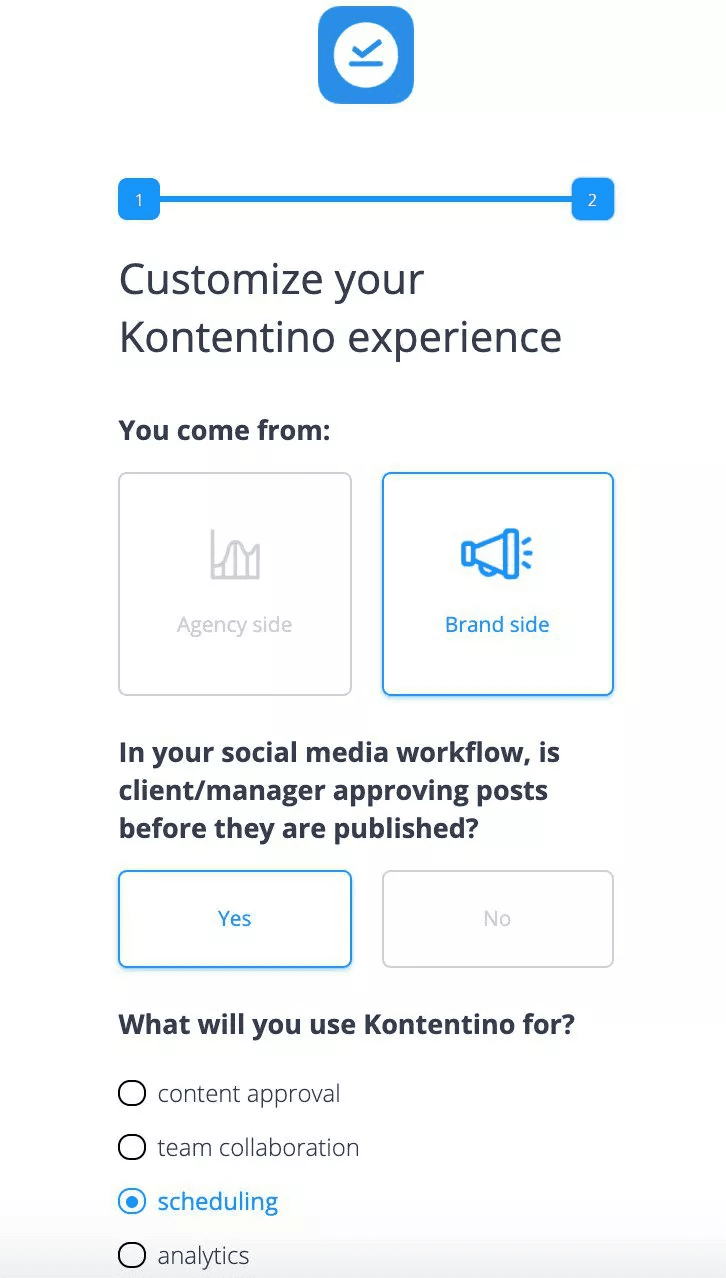
Once you have that data on JTBD, you can divide your users into segments sharing similar characteristics. Tools like Userpilot allow you to do just that.
Create mobile-first onboarding flows with Userpilot, customizing welcome screens, carousels, and slideouts to deliver personalized messaging.
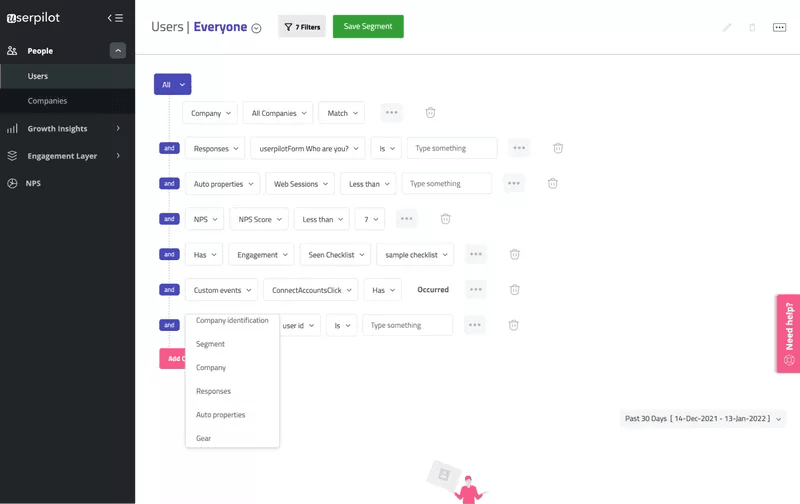
Trigger relevant checklists to each user segment
Having identified the customer jobs-to-be-done and having classified them into segments, you need to showcase the most relevant features for each of them.
Checklists are a very effective way to drive engagement with features that are relevant for specific user segments.
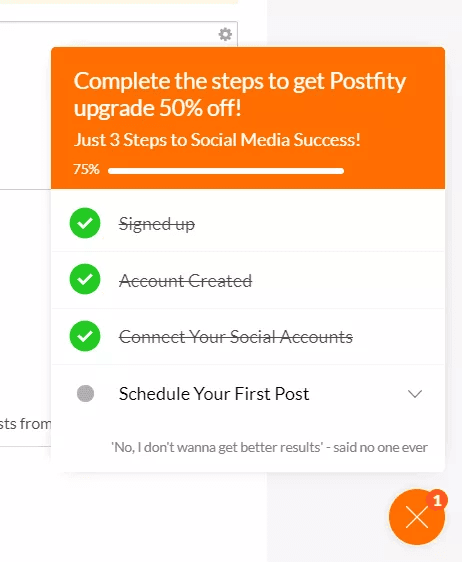
Expose users to new and relevant features for them
Announcement modals and native tooltips are another way of leading your users to the features and functionalities that they will benefit from.
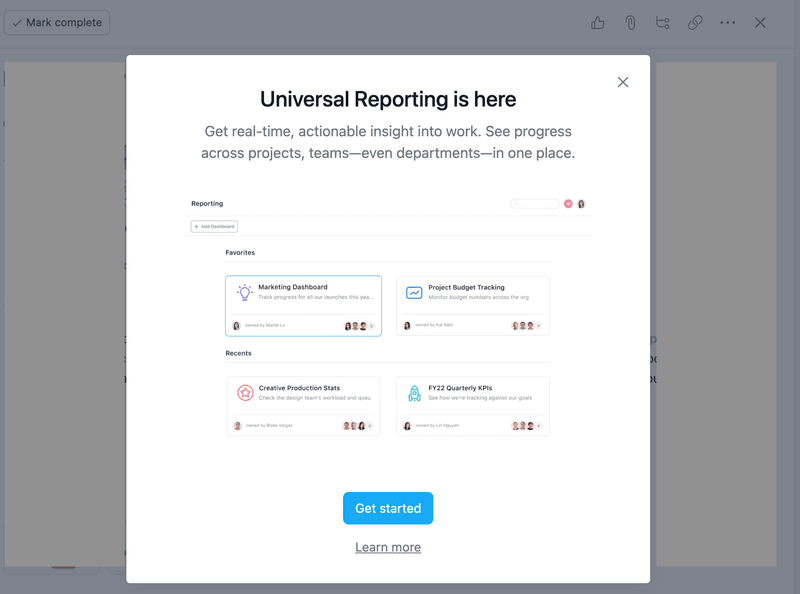
As was the case with checklists, it is important to use segmentation to target specific user groups so that they are exposed only to the features that are relevant to them. Indiscriminate overloading with irrelevant content is the quickest way to annoy your users.
Ask the right users for feedback on potential or newly released features
Making the users engage with a feature is only half of the job. Even if they use the features to achieve their objectives successfully, there’s always room to further improve your product. That’s why never stop asking your users for feedback.
Applications like Userpilot allow you to design in-app surveys. You can use them to easily solicit feedback from the user segments that rely on a feature to get their jobs done the most.
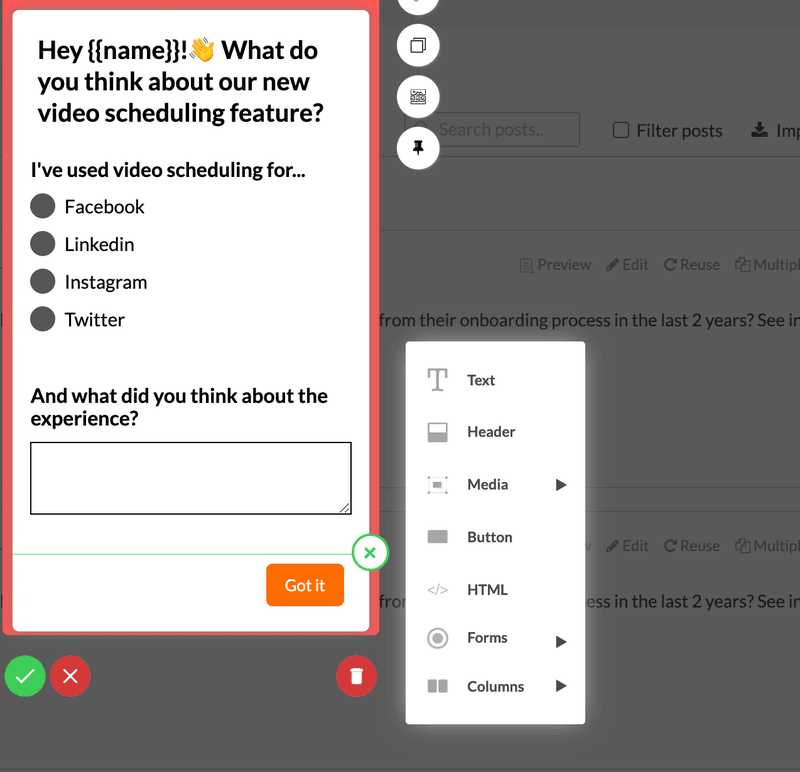
Conclusion
Thanks to Jobs-To-Be-Done, product management processes get more focus. Product managers can use it to identify the needs of their existing and potential customers. They can use the knowledge for product discovery, marketing, and user onboarding.
If you would like to see how you can use Userpilot to implement the framework for user onboarding to drive product adoption, click the link to get a free demo!







